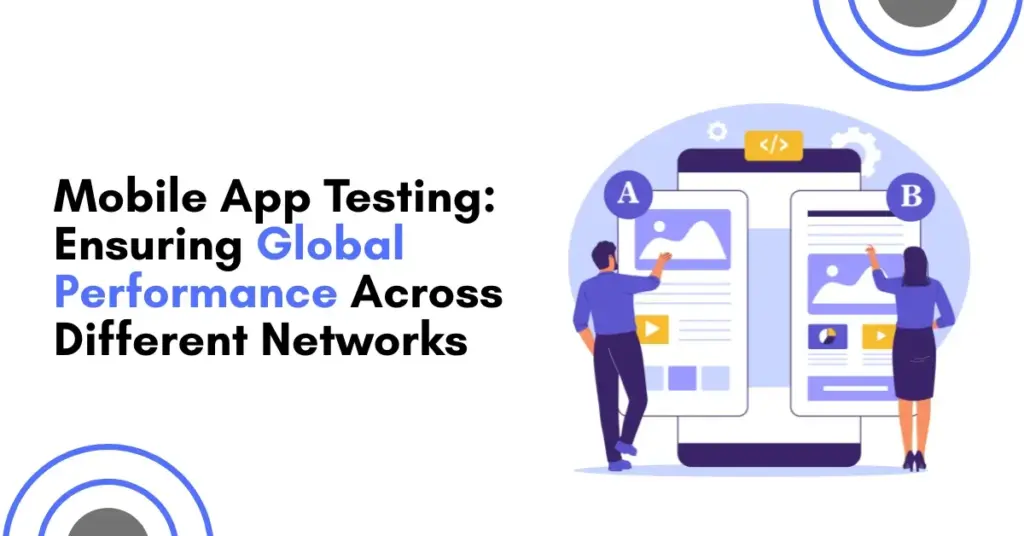Your app crashes in Mumbai but runs perfectly in Manhattan. Sound familiar? Network variability kills more mobile apps than bad code ever could.
Testing across different networks isn’t optional anymore. With 6.8 billion smartphone users worldwide, your app faces wildly different connection speeds, latencies, and infrastructure quirks.
Table Of Contents
The Network Testing Challenge Nobody Talks About
Mobile networks behave unpredictably. A 5G connection in Seoul delivers 500 Mbps while 3G in rural Indonesia struggles at 2 Mbps. But speed isn’t the only variable wreaking havoc on app performance.
Packet loss rates fluctuate between 0.1% and 15% depending on location and time. Network handoffs between cell towers introduce random latency spikes that can freeze your UI for seconds. And that’s before considering how different carriers implement their own traffic shaping policies.
Real-world testing reveals shocking disparities. Netflix’s engineering team discovered their app consumed 40% more battery on certain Indian networks due to aggressive reconnection attempts. Instagram found that image uploads failed 8x more often in Southeast Asia compared to North America, despite similar connection speeds.
Breaking Down Network Variables That Impact Performance
Network conditions create a complex testing matrix. Bandwidth obviously matters, but latency often causes worse user experiences than slow speeds.
Consider how latency compounds across API calls. Your app makes 12 requests during startup. At 50ms latency, that’s manageable. But at 300ms latency common in emerging markets, you’re looking at 3.6 seconds before the first meaningful paint. Users abandon apps after 3 seconds of waiting.
Jitter introduces another layer of complexity. Consistent 200ms latency feels smoother than fluctuating between 50ms and 400ms. Mobile networks exhibit high jitter during peak hours, when users switch between towers, or in areas with weak coverage. Your app needs to handle these variations gracefully or risk appearing broken.
Connection stability varies dramatically by region. European 4G networks maintain persistent connections for hours. Meanwhile, networks in parts of Africa and Asia drop connections every few minutes to manage congestion. Apps that don’t implement proper retry logic and session management fail catastrophically in these environments.
Geographic Testing Strategies That Actually Work
Smart companies stopped relying on emulators years ago. Simulated network conditions miss crucial real-world behaviors like carrier-specific throttling and regional CDN performance.
Physical device farms in target markets provide authentic results but cost fortunes. Running 50 devices across 10 countries burns through $100,000 monthly. Smaller teams need more practical approaches.
IPRoyal’s mobile proxy solutions enable testing through actual mobile networks without maintaining device farms. By routing traffic through real carrier connections, developers experience genuine network conditions including carrier-grade NAT behavior, mobile-specific compression, and authentic handoff patterns.
The testing pyramid for mobile networks should include three layers. Start with automated tests using network simulation for basic scenarios. Then run integration tests through mobile proxies to validate real carrier behavior. Finally, conduct targeted beta tests with actual users in priority markets.
Performance Metrics That Predict Real User Experience
Traditional metrics like response time tell incomplete stories. Mobile users care about perceived performance more than actual speed.
Time to Interactive (TTI) correlates strongly with user retention. Apps achieving TTI under 5 seconds retain 70% more users than those taking 10 seconds. But TTI varies wildly across networks. An app hitting 3-second TTI on LTE might take 15 seconds on congested 3G.
Frame rate stability matters more than peak FPS. Users prefer consistent 30 FPS over fluctuating between 60 FPS and 15 FPS. Network delays cause frame drops when UI updates wait for server responses. Testing must measure frame consistency across different latency conditions.
Battery consumption during network operations directly impacts app reviews. Aggressive polling and excessive reconnection attempts drain batteries fast. According to research from MIT, poorly optimized network code increases battery usage by up to 300% compared to efficient implementations.
Implementing Adaptive Network Strategies
Static network handling guarantees failure across diverse conditions. Modern apps must adapt behavior based on connection quality.
Netflix pioneered adaptive bitrate streaming, but the concept extends beyond video. Spotify pre-downloads content on fast connections and reduces audio quality on slow networks. Google Maps switches between vector and raster tiles based on bandwidth availability.
Implement progressive loading for content-heavy features. Load critical UI elements first, then enhance with images and secondary data as bandwidth allows. This approach maintains usability even on 2G connections while providing rich experiences on faster networks.
Network-aware caching strategies prevent redundant downloads. Cache aggressively on unlimited connections but conserve storage on metered plans. Use connection type APIs to detect WiFi versus cellular and adjust behavior accordingly. The Android Developers guide provides detailed implementation patterns for network-aware apps.
Regional Network Characteristics and Testing Priorities
Different regions exhibit unique network behaviors requiring targeted testing approaches. Understanding these patterns helps prioritize testing efforts.
Asian markets show extreme diversity. Japan and South Korea boast world-leading 5G penetration with consistent sub-20ms latency. But neighboring countries like Myanmar and Cambodia rely heavily on 3G with frequent disconnections. Apps must handle this 100x performance difference within the same geographic region.
European networks provide relatively consistent 4G coverage with predictable behavior. But roaming between EU countries introduces complexity. Apps need to handle network changes without disrupting user sessions when people cross borders.
Latin American networks struggle with congestion during peak hours. Connection speeds drop 70% between 6 PM and 10 PM in major cities. Testing during these congestion windows reveals performance bottlenecks invisible during off-peak testing.
African markets present unique challenges with expensive data plans and creative workarounds. Users frequently switch SIM cards for better rates, causing apps to lose persistent identifiers. Payment features must account for mobile money integration, not just credit cards.
Automation Tools and Testing Frameworks
Manual testing across network conditions doesn’t scale. Automation frameworks must simulate realistic network scenarios while maintaining test reliability.
Facebook’s Augmented Traffic Control provides granular control over network conditions. Engineers can model specific carrier behaviors including asymmetric bandwidth, burst patterns, and connection migrations. The tool integrates with existing CI/CD pipelines for continuous network testing.
Charles Proxy and Proxyman enable request-level network manipulation. Testers can inject delays, drop packets, and modify responses to validate error handling. These tools excel at reproducing specific user-reported issues that occur under unusual network conditions.
For comprehensive testing, combine multiple approaches. Use headless browsers with network throttling for quick smoke tests. Deploy real device clouds for critical user journeys. And leverage mobile proxies for authentic carrier testing without infrastructure overhead.
Learning from Production: Monitoring and Optimization
Production monitoring reveals network issues that testing misses. Real users encounter edge cases that controlled testing environments can’t replicate.
Implement distributed tracing to track request paths across networks. When Pakistani users report slow checkout, traces might reveal that payment API calls route through European servers, adding unnecessary latency. These insights drive architectural improvements.
A/B testing different network strategies in production provides definitive answers. Uber tested various request timeout values across markets, discovering that 8-second timeouts optimized success rates in India while 3-second timeouts worked better in the US.
Track network-specific crash rates and ANRs (Application Not Responding). Certain Android devices on specific carriers exhibit unique behaviors causing crashes. Samsung devices on Verizon, for example, implement aggressive battery optimization that kills background network tasks. According to Firebase’s crash reporting documentation, network-related crashes account for 23% of total app crashes globally.
The Future of Global Network Testing
5G rollout promises revolutionary changes but introduces new testing complexities. Network slicing allows carriers to provide different service levels to different apps. Your competitor might pay for priority traffic while your app gets throttled.
Edge computing shifts processing closer to users, reducing latency but complicating deployment. Apps must detect and utilize edge nodes when available while maintaining fallback paths to central servers.
Satellite internet from SpaceX and Amazon will connect previously unreachable users. But satellite connections exhibit unique characteristics like 600ms base latency and weather-dependent reliability. Apps must prepare for these new network profiles.
Testing strategies must evolve continuously. What works today becomes obsolete as networks upgrade and user expectations shift. Build flexibility into your testing infrastructure to adapt quickly. The companies that master global network testing will dominate international markets while others remain trapped in their home regions.
How useful was this post?
Average rating 5 / 5. Votes: 2
No votes so far! Be the first to rate this post.

With 15+ years of experience in custom SaaS development, product, management focused on digital media and multi-platform customer experience. Over the last 10 years, I have established 4 successful businesses and managed 100+ people between the four businesses.






